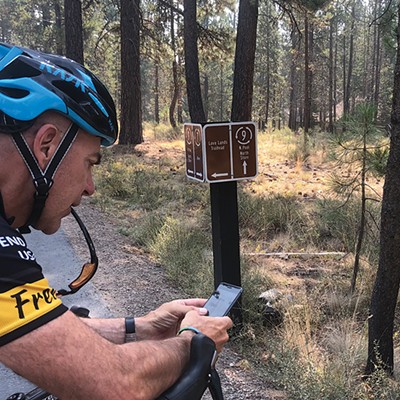Saturday sucked.
I spent four hours pedaling my mountain bike, slowly, over trails that are usually dotted with king boletes this time of year. Last year, I filled my Camelback with the tasty mushrooms in less than two hours. This year—not a single goddamn one! Am I doing something wrong?
Apparently not, according to Linda Gilpin, an area fungus enthusiast who teaches a four-week mushroom education class at Central Oregon Community College. Gilpin, who is also the webmaster for the Central Oregon Mushroom Club, said that the months-long drought has made for slim pickings as we roll into autumn—usually the best time to harvest boletes and other scrumptious fungal treats.
“It’s pretty tricky right now because it’s so dry,” Gilpin said, which made me feel like less of a mycological failure. Gilpin added that she’s had recent luck finding chanterelles, but said she had to travel to find them. In marshy, low-lying areas near Santiam Pass, chanterelles are plentiful, offered Gilpin, even with minimal precipitation.
Other locals have also fared well by targeting shaggy manes, rather than boletes, chanterelles or matsutakes, another Central Oregon favorite (the only variety that requires a for-cost permit from the Forest Service. See side bar). Even better, shaggy manes can be found in suburban areas, like your neighbor’s lawn.
“We just picked a barrel full (of shaggy manes),” said one area mushroom hunter who wished to remain unnamed. In keeping with his undercover shtick, he refused to disclose exactly where he found the edible delights, though he did allow that he discovered hundreds of white bell-shaped caps busting through the soil at the entrance to a prominent westside neighborhood.
“You have to eat shaggys soon after harvesting them,” said the area expert. “Otherwise they turn bad quickly.” The stealthy mushroom fiend said he often sautés them in butter or coconut oil and adds them to pizzas, pastas, soups and stir-fries.
Boletes, Gilpin said, keep much better, provided that you gather and store them in a paper bag and not plastic bags that cause mushrooms to sweat and rot.
“I generally like to dry the boletes, then rehydrate them,” said Gilpin. It has a nutty flavor—it’s just my favorite dry.”
Though there are no boletes to be found yet, save for a couple emaciated ones I saw near North Fork trail, that should change soon.
“As soon as the rain comes, it’s a wonderland out there,” said Gilpin.
Gilpin offered a few helpful tips for those who are interested in harvesting their own mushrooms this fall. The most dangerous aspect of fungus finding, however, isn’t what you think.
“Because you’re always staring at the ground, it’s so darn easy to get lost,” Gilpin said. Always hunt with a partner, remain within earshot and bring a map.
Obviously, accurate identification is also crucial. Gilpin said to not overlook the second-chance I.D. opportunity afforded once you’re back in the comfort of your well-lit kitchen.
“If you’re unsure, it’s going to make you sick anyway,” Gilpin said. She wisely explained that even if your chosen mushroom is edible, you can make yourself sick with worry, so it’s best to not bother. Eat only those mushrooms you’re sure of.
If you’re keen to harvest your own, look locally for shaggy manes, which can be found now in grassy areas or along gravel roads. Otherwise, wait for the rains to come and then revel in Gilpin’s wonderland.
Wondering where to find these wonderlands? Me too. Mushroom hunters are notoriously secretive and gleaning an exact harvest location from a mushroom hunter is about as easy as scoring a Sasquatch sighting. But I don’t think anyone will mind me writing that our area trails, particularly those close to a water source, are often a good place to start.
And I take back what I said about Saturday.
I learned some stuff and I was outside in shirtsleeves on the first day of fall, which was awesome, actually.
If you want to embark on your own mushroom mission you’ll need a permit. But don’t worry—they’re free. To get your own, stop by any of the four regional Forest Service buildings. The permits, which you to gather up to
two gallons per day,
come with a helpful map.
Here’s what you're likely to find around Central Oregon:
Bolete (boletus edulis)
Matsutake (tricholoma matsutake)
Hericium (hydnum coralloides)
Milk Caps (lactarius volemus)
Shaggy Mane (coprinus comatus)
Chanterelle (catharellus cibarius)



















